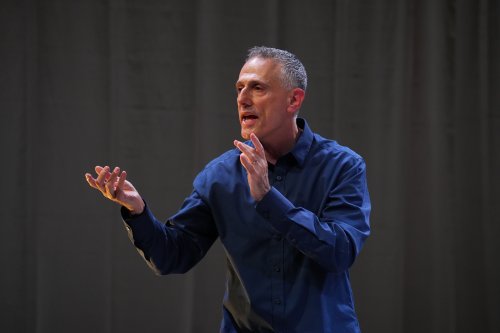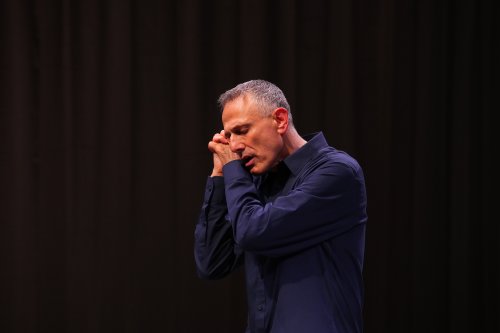Four Saints in Three Acts
David Greenspan demonstrates how to perform an opera without music.

David Greenspan in a scene from “Four Saints in Three Acts” at The Doxsee @ Target Margin Theater (Photo credit: Steven Pisano)
[avatar user=”Joel Benjamin” size=”96″ align=”left”] Joel Benjamin, Critic[/avatar]
David Greenspan, the master of the solo show, has taken on Eugene O’Neill’s Strange Interlude and Barry Conners’ The Patsy. These are just a few of his theatrical accomplishments which also include ensemble work. Who, but Greenspan, would take on the maddeningly surreal Gertrude Stein libretto of the opera Four Saints in Three Acts?
Gertrude Stein’s scenario, written in 1927 and set to music by Virgil Thomson for a history-making 1928 performance featuring an all-Black cast, is as lucid/opaque as any of her writings. It leads the listener astray while it also charms with its childlike exuberance matched by Greenspan’s witty interpretation.
Stein, who was a friend and mentor to painters, including Picasso, as well as avant-garde composers during that tumultuous, rich period of Parisian artistic history of the twenties, produced works that—as clichéd as it may sound—painted pictures with words and made music with rhythms and sounds.

David Greenspan in a scene from “Four Saints in Three Acts” at The Doxsee @ Target Margin Theater (Photo credit: Steven Pisano)
The inventive Greenspan did both, not to mention display his usual extraordinary memorization skills, considering that the script only occasionally makes literal sense. (Despite the title, this is not in any sense a play about religion.)
The title, itself, is one of Stein’s verbal pranks. There are at least twenty saints and nearly six acts—nearly, because one consists of just three or four lines of dialogue. The Saints are led by Saint Theresa and Saint Ignatius and include several who aren’t Saints at all (Saint Settlement, Saint Plan).
After a long introductory passage playfully tossing about the names of the many Saints, Act One is announced, in which Saint Theresa’s many repetitious activities are described, leading eventually to Saint Ignatius and his thoughts. From then on the play is a riot of words, words and more words.

David Greenspan in a scene from “Four Saints in Three Acts” at The Doxsee @ Target Margin Theater (Photo credit: Steven Pisano)
Stein plays with homonyms (scene/seen); uses many, many repetitions (“By this clock o’clock, by this clock, by this clock o’clock by this clock”); makes up fanciful back stories; and conjures poetic images (“Ordinary pigeons and trees”). When performed with Thomson’s score and sung by many different singers the script may make more sense, but Greenspan almost makes the need for music moot.
Greenspan isn’t always totally clear when switching points of view, but made up for this by turning the entire, long script into a wonderland of gestures, vocalizations, postures and movements. His eyes and his hands are masterful communicators. His lean body’s dancelike movements add dimension to the onslaught of words. This is a performance that must be seen to appreciate how mindboggling his accomplishment is.
Yuki Nakase Link’s elegantly simple carpeted platform and Ken Rus Schmoll’s sleek direction free Greenspan to create his very individual magic.
Four Saints in Three Acts is a production of the Lucille Lortel Theatre, but is performed at the Doxsee Theatre in Brooklyn.
David Greenspan in Four Saints in Three Acts (through October 9, 2022)
The Lucille Lortel Theatre
The Doxsee @ Target Margin Theater, 232 52nd Street, in Brooklyn
For tickets, call 212-924-2817 or visit http://www.lortel.org
Running time: one hour and 35 minutes without an intermission






Leave a comment